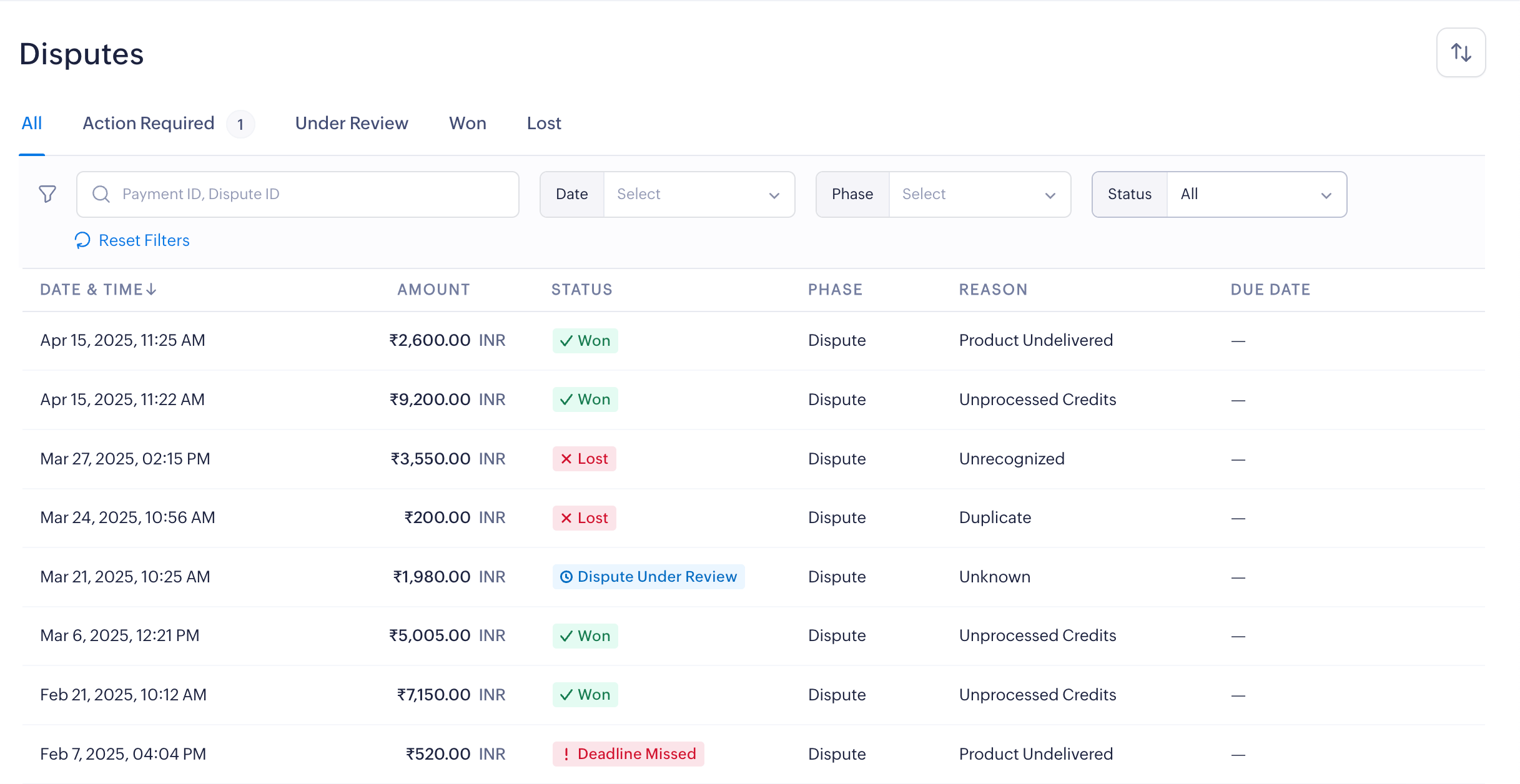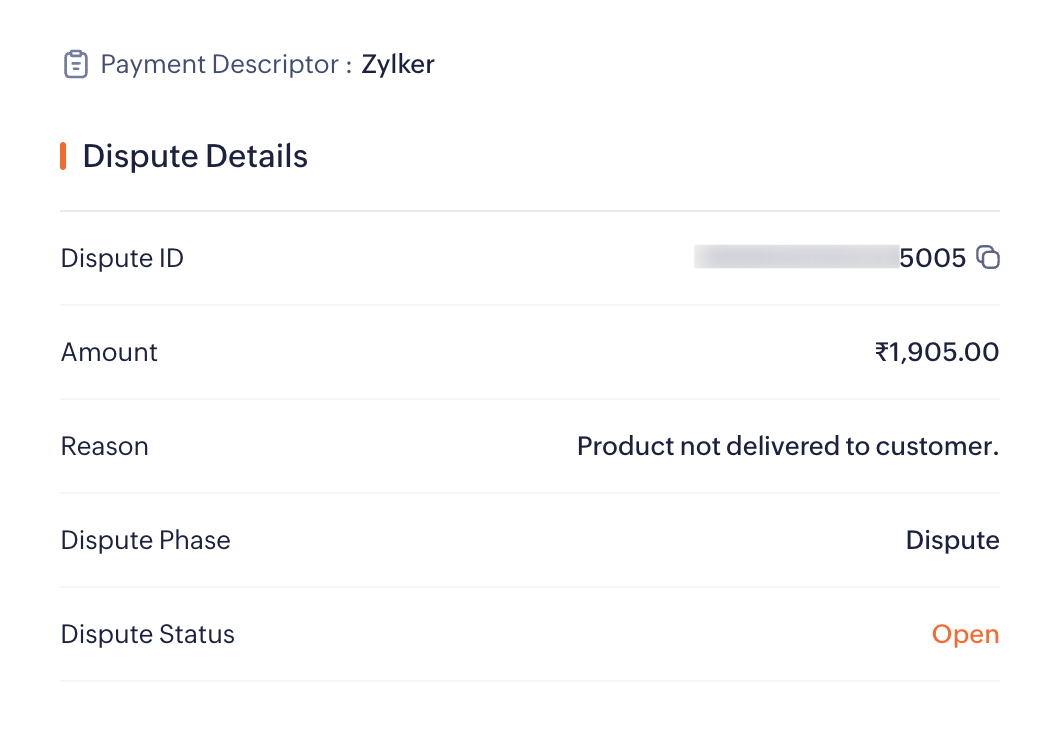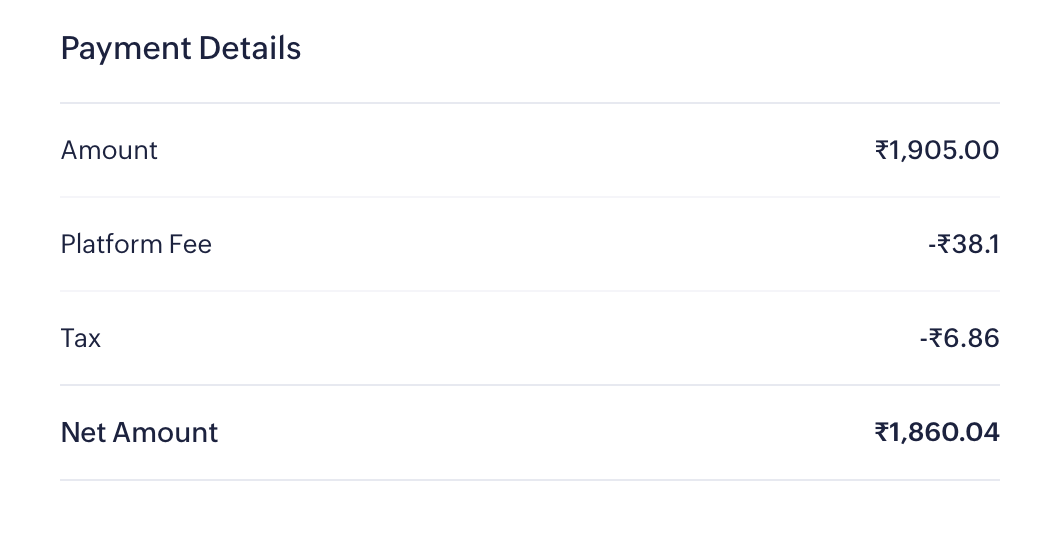Viewing Disputes
The Disputes module in the left sidebar displays all the transactions disputed by your customers.
The list view provides the basic details of all disputes, such as the Dispute Date, Amount, Status, Reason, and Customer Details.

Clicking a dispute lets you drill down and view the details.
Dispute Details
When a customer raises a dispute against a transaction, the payment will be available in the Dispute list view. You can switch between tabs and click on a dispute.
The dispute details page contains the following sections:
Dispute Overview
This section gives a summary of the dispute. It describes why the dispute was raised, the current status, the amount and fee (if any), and the deadline for responding to the dispute.
It also includes Date and Time, Customer Details, Payment Method, and Transaction Description.

Dispute Details
This section contains the Dispute ID, Disputed Amount, Reason, Phase, and Status of the dispute.
Insight: The Dispute ID can be used to track the status of your dispute in your emails.

A transaction could be disputed for the following reasons:
- Credit not processed for returned items or cancelled transaction.
- Duplicate payment.
- Fraudulent payment.
- Product not delivered to customer.
- Product not accepted by customer.
- Subscription cancelled by customer.
- Transaction not recognised by customer.
- Other reasons.
Payment Details
This section contains the details of the relevant payment that was disputed. It includes the Payment Descriptor you had provided in your settings, the Amount Paid by the customer, the Platform Fee, the Disputed amount, and the final Net Amount after disputes or refunds.

Payment Method
In case of card payments, this section gives you all the details regarding the card used, such as the Card Number, Card Type, Card Network, Expiry Date and the card’s Origin.
Comments & History
A log of all the actions performed on your transaction is tracked under this section. Every step, right from payment collection until the dispute has been closed, can be tracked here. Users will also be able to add comments for internal reference.

Other Actions
This section allows you to respond to disputed transactions by issuing refunds or submitting evidence to challenge them.
Dispute Statuses and Phases
Dispute Statuses
Based on the dispute workflow, disputes are categorised into the following statuses:
| Status | Description |
|---|---|
| Open | Dispute created directly by the customer and requires your response. |
| Dispute Under Review | Dispute that’s being reviewed based on the merchant’s response. |
| Won | Dispute resolved in the merchant’s favour. |
| Partially Won | Dispute partly resolved in the merchant’s favour. |
| Lost | Dispute resolved in the customer’s favour. |
| Accepted | Dispute accepted by the merchant. |
Dispute Phases
In India, the dispute process includes three phases:
| Phase | Description |
|---|---|
| Dispute | The initial stage where a transaction is contested by the customer. |
| Pre-Arbitration | A second review phase if the dispute remains unresolved after the initial response, allowing for further evidence submission. |
| Arbitration | The final phase where the card network or NPCI makes a binding decision based on the submitted evidence if the dispute is still unresolved. |
Filter Disputes
If you’d like a filtered view of the disputes, you can:
Switch between the dispute categories
The Dispute module categorises disputes vastly into:
- All: Lists all the disputed transactions.
- Action Required: Lists only the newly created inquiries and disputes that require your response.
- Under Review: Lists the disputes being reviewed.
- Won: Lists the disputed won by the merchant.
- Lost: Lists the accepted, lost, and partially-won disputes.
Simply switch between the categories to view the dispute you’re looking for.
Search for a specific transaction
Use the search bar to look for a particular transaction. You can search by the Payment or Dispute ID to find the exact transaction you’re looking for.
Filter by date or status
Use the Date, Status and phase filters to narrow your search and view based on specific dates and status. You can choose from the default date list or choose a custom date range to figure out your transaction.
